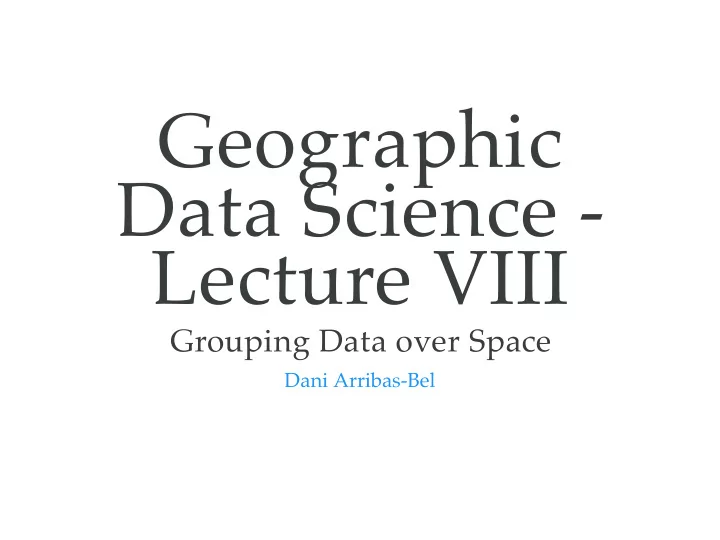

Geographic Data Science - Lecture VIII Grouping Data over Space Dani Arribas-Bel
Today The need to group data Geodemographic analysis Non-spatial clustering Regionalization Examples "in the wild"
The need to group data
Everything should be made as simple as possible, but not simpler Albert Einstein
The need to group data The world (and its problems) are complex and multidimensional Univariate analysis involves focusing only one way of measure the world
The need to group data The world (and its problems) are complex and multidimensional Univariate analysis involves focusing only one way of measure the world Sometimes, world issues are best understood as multivariate : Percentage of foreign-born Vs. What is a neighborhood? Years of schooling Vs. Human development Monthly income Vs. Deprivation
Grouping as simplifying Define a given number of categories based on many characteristics (multi-dimensional) Find the category where each observation fits best Reduce complexity , keep all the relevant information Produce easier-to-understand outputs
Geodemographic analysis
Geodemographic analysis Technique developed in 1970’s attributed to Richard Webber Identify similar neighborhoods → Target urban deprivation funding Originated in the Public Sector (policy) and spread to the Private sector (marketing and business intelligence)
Source
Source
How do you segment/cluster observations over space? Statistical clustering Explicitly spatial clustering (regionalization)
Non-spatial clustering
Split a dataset into groups of observations that are similar within the group and dissimilar between groups, based on a series of attributes
Machine learning Unsupervised
Machine learning The computer learns some of the properties of the dataset without the human specifying them Unsupervised
Machine learning The computer learns some of the properties of the dataset without the human specifying them Unsupervised There is no a-priori structure imposed on the classification → before the analysis, no observations is in a category
Intuition
K-means [ ] Source
K-means [ ] Source
More clustering... Hierarchical clustering Agglomerative clustering Spectral clustering Neural networks (e.g. Self-Organizing Maps) DBScan ... Different properties, different best usecases See interesting comparison table
Regionalization
Machine Learning
Spatial Machine Learning
Spatial Machine Learning Aggregating basic spatial units ( areas ) into larger units ( regions )
Regionalization Split a dataset into groups of observations that are similar within the group and dissimilar between groups, based on a series of attributes ...
Regionalization Split a dataset into groups of observations that are similar within the group and dissimilar between groups, based on a series of attributes ... ...with the additional constraint observations need to be spatial neighbors
Regionalization Duque et al. (2007)
Regionalization All the methods aggregate geographical areas into a predefined number of regions, while optimizing a particular aggregation criterion; Duque et al. (2007)
Regionalization The areas within a region must be geographically connected (the spatial contiguity constraint); Duque et al. (2007)
Regionalization The number of regions must be smaller than or equal to the number of areas; Duque et al. (2007)
Regionalization Each area must be assigned to one and only one region; Duque et al. (2007)
Regionalization Each region must contain at least one area. Duque et al. (2007)
Regionalization All the methods aggregate geographical areas into a predefined number of regions, while optimizing a particular aggregation criterion; The areas within a region must be geographically connected (the spatial contiguity constraint); The number of regions must be smaller than or equal to the number of areas; Each area must be assigned to one and only one region; Each region must contain at least one area. Duque et al. (2007)
Algorithms Automated Zoning Procedure (AZP) Arisel Max-P ... See Duque et al. (2007) for an excellent, though advanced, overview
Examples
Census geographies
AirBnb neighborhoods
Livehoods
Recapitulation Some problems are truly highly dimensional and univariate representations are not appropriate Clustering can help reduce complexity by creating categories that retain statistical information but are easier to understand Two main types of clustering in this context: Geo-demographic analysis Regionalization
Geographic Data Science'15 - Lecture 8 by Dani Arribas-Bel is licensed under a Creative Commons Attribution- NonCommercial-ShareAlike 4.0 International License .
Recommend
More recommend